When the words dog and art appear in the same sentence, rest assured that at least someone will think of Jeff Koons and his sculptures. It’s amazing how easily he appropriated something so widespread and innocent as a domestic animal. But what about other genres – painting for example? Although the technique was proclaimed dead by Paul Delaroche in 1839, practice proves him wrong, and there are plenty of painters from the 20th and the 21st century, who obviously couldn’t resist making a portrait of at least one dog. Pets, non-pets, puppies or hounds, man’s best friends seem to be a remarkable subject of representation. Dogs are what they are – wolf-like animals, which were the first to be domesticated by humans. However, this long history of a relationship between men and dogs has preconditioned human society and individuals to view dogs as their friendly companions. For many people, a dog (especially their own dog) is more than just an animal. Our pets easily become part of our family. Although idiosyncratic and eccentric by default, artists are no exception here. There are lots of artists who were known for special relationships with their dogs – Andy Warhol and Archie, Picasso and Lump, David Hockney and Stanley and Boodgie (to name a popular few). So let us delve into the traits and the symbolic meaning of a dog, as seen through the eyes of 10 influential artists from the 20th century.
Editors’ Tip: David Hockney’s Dog Days
The book is a delightful collection of David Hockney’s paintings, in which he represented the two of his dachshunds. Since “dogs are not very interested in art”, as Hockney says, these paintings come as a result of both sharp observation and affection, followed by lyrical studies in form and design A text by the artist is included, and it gives a behind-the-scenes glimpse of how to work with models that don’t necessarily want to sit still. The book contains 84 color illustrations.
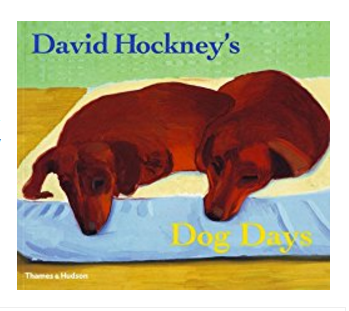
David Hockney - Dog Days
You may have noticed that David Hockney was mentioned more than once in this article. During the ’90s, one of Britain’s best-known and most admired painters went through a phase of a certain fascination with his dachshunds. From September 1993, all he did was painting and drawing his dogs. This, naturally, resulted in a collection of remarkably warm, endearing paintings which depict Stanley and Boodgie in a variety of postures and situations. Through close examination, attentiveness and care, both towards his dogs and the paintings, Hockney managed to find a way to truthfully represent two adorable, and yet constantly active creatures, whose lives are “dominated by food and love“. Hockney’s figurative paintings were a bit out of fashion, in comparison with the global trends in art of the ’90s. Therefore, he made an unapologetic apology: “I make no apologies for the apparent subject matter. These two dear little creatures are my friends. They are intelligent, loving, comical and often bored. They watch me work; I notice the warm shapes they make together, their sadness and their delights. And, being Hollywood dogs, they somehow seem to know that a picture is being made“.
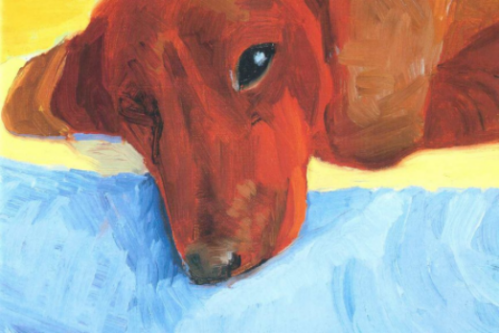
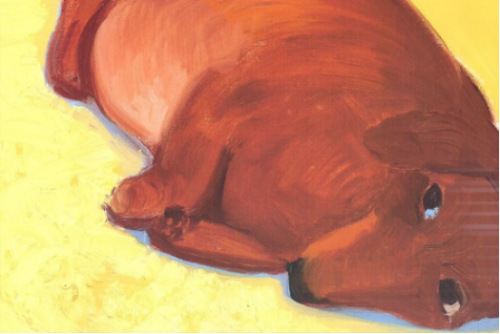
Francis Bacon - Studies of a Dog
Now, this is going to be a bit of a shocker, coming after Hockney’s tear-jerking dog portraits. But, Bacon will be Bacon and Hockney will be Hockney, and it seems that not all the painters from Britain expressed their emotions with the same sentiment. While Hockney translates his closeness to his dogs in a romantic manner, Bacon observes the dog from a distance, allowing for it to appear as a mysterious stranger with an uncertain character. The dog may be violent, or it may be anxious and vulnerable – we don’t know for sure.Ultimately, the paintings don’t seem to really be about dogs themselves, but probably about what they can represent, chasing their own tales or standing impatiently next to their owners. As Deleuze had suggested, with Bacon, it’s all about the composition of the image: For Bacon the dog is not only centre stage but is, to extend the analogy, the entire play. (on 1952 ‘Study of a Dog’)
(Francis Bacon- Dog chasing tail)
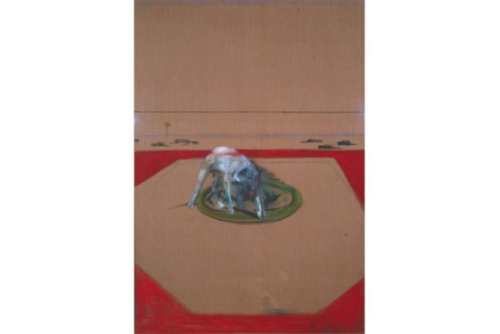
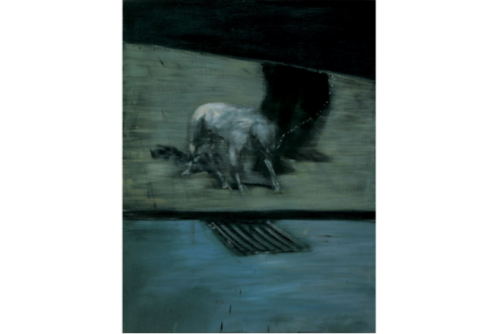
Lucian Freud - Double Portrait(s)
Lucian Freud returned to depicting dogs several times in his long career. One thing that all these paintings have in common is the human presence. Dogs are never portrayed alone, rather always in correlation with a human being. In 1951, the artist made a painting of his pregnant wife, sitting in calm silence, next to a pet dog. The silence presented in this painting is somewhere between loneliness and peacefulness, and it is this loneliness that characterizes most of Freud’s work. However, it seems like the dog makes it possible for the feeling not to gravitate toward either of the two.Freud created a great number of paintings which include dogs later on, and it is always the silence that takes a different form in these artworks. With dogs in the picture, silence always seems to be a way of communicating, rather than an unpleasant lack of sound.

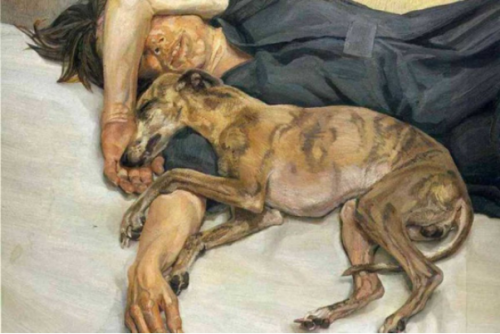
Vera Barnett after Otto Dix
The painting by Vera Barnett is an interpretation of Otto Dix‘s Hugo Erfurth with Dog, made in 1926. Be it because of the inflatable aesthetics, reminiscent of Koons’ puppies, or due to the humorous approach, the painting looks irresistibly postmodern. All of the characters that appear in her artworks have a strange appeal which reminds us of pool toys. Apart from the witty re-makes of popular paintings (and this particular one accidentally includes a dog as well), Barnett often presents domestic animals as toys, which are neither inanimate nor alive. Vera’s version of Dix’s painting is entitled “The artist and his dog”. In both paintings, you gotta love the dog’s goofy tongue, especially in comparison with the seriousness of the owner.
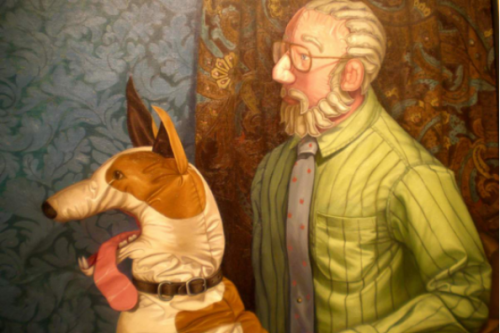

Jean Michel Basquiat - Boy and Dog in a Johnnypump
The forever adored and never forgotten Jean-Michel Basquiat made several paintings which incorporate dogs, and I suppose we all know the most famous one. Boy and Dog in a Johnnypump is Basquiat’s work dating from 1982, and according to G. Fernández, it helped Basquiat “reach the zenith of his talent”. The primitive, expressive approach to painting, which is typical for Basquiat’s work, shows a boy and a dog playing, but in a slightly unsettling manner. We’re not actually even sure of what happens in the painting, instead we are left impressed by the raw color and the idiosyncratic style in which both the dog and the boy are depicted.

Joan Miro’s Barking Dogs
Joan Miro made a few paintings which depict dogs barking at the moon, or standing in front of the sun. But if you know Miro’s work, you probably know that most of us wouldn’t have guessed that there were any dogs in the painting, if there wasn’t for the title. The first one was made in 1926, and it depicts a dog in an eerie, darkish landscape, accompanied by a strange ladder which leads to the sky. In his own, magical way, Miro turns a distorted image into asentimental narrative. Another Dog Barking at the Moon was created in 1952, and it is a litograph, more colorful than the previous one. There’s also Figures and Dog in front of the Sun, made in 1949 – you can see all three in the slider.
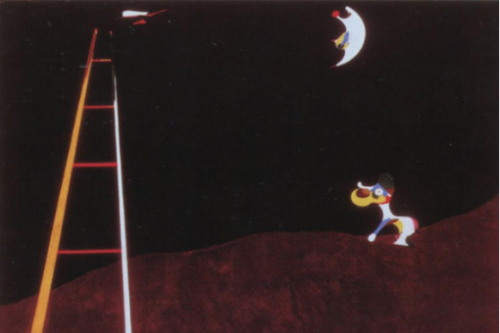
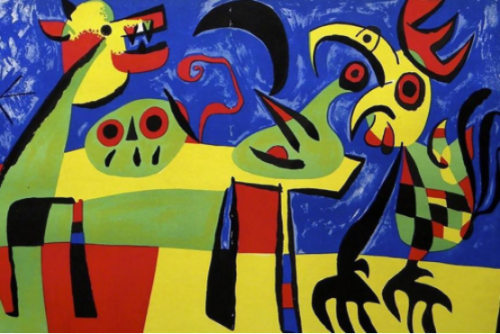
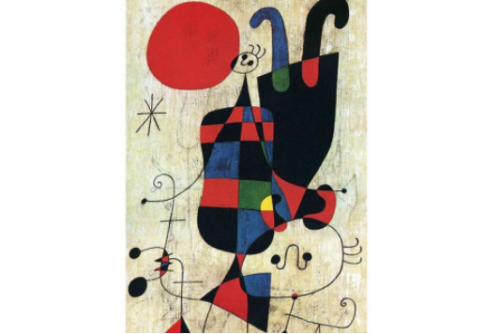
Keith Haring’s Barking Dogs
Keith Haring‘s dogs are barking as well, but the sentiment is less romantic. Haring used his visual symbols as elements of a new language, and it helped him send meaningful messages to the world. A barking dog is a tag which is believed to symbolize power, and sometimes repression, which demands obedience and represents authority. At times, the dogs take on a human form, and molest the human characters which he also used to depict quite often. This human-dog combination brings out the “negative” side of a violent, barking dog. We could have perhaps seen the good side as well, but Haring died young, in 1990. Nevertheless, his symbols are eternal and we can discuss their meaning forever.

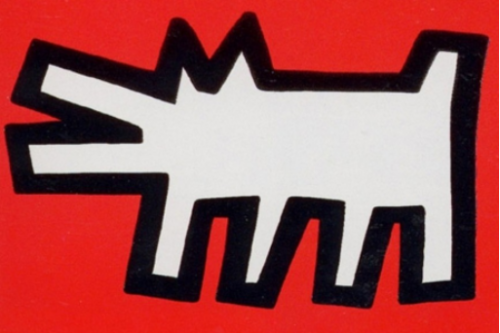
Roy Lichtenstein - Grrrrrrrrrrr!!
Made in Roy Lichtenstein‘s signature style, Grrrrrrrrrrr!! (1965) displays a seemingly angry dog. As usual, the artist used Ben-day dots and black strokes to depict his protagonist. The inspiration came from a comic book, however only a portion of the dog’s face is visible in it, meaning that the dog’s facial expression is Lichtenstein’s original creation. As you can see, the dog’s eyebrows reveal its fury, which is an occurrence you’ll never experience in reality. So once again, the canine is given human traits (even though hes speech bubble doesn’t contain real words).
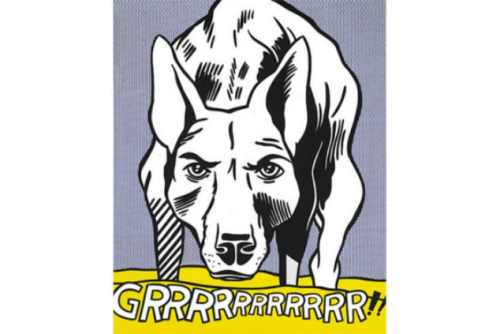
Itzcuintli Dog with Frida Kahlo
As you already know, the famous Mexican painter used to make self-portraits quite often. Every once in a while, these used to involve other characters as well, hummingbirds, monkeys, wounded deer, and – a tiny little dog. Frida Kahlo was photographed with her dogs several times, and these photos are perhaps the most famous of hers. In one of her paintings from 1938, Itzcuintli Dog with Me, Frida depicted a small Mexican dog, standing next to her heavy black dress. Allegedly, dogs represent death in the ancient Mexican culture, but it was never confirmed that Frida had this in mind. A fact is, however, that she often sought comfort in her animals, to compensate the pain caused by her inability to have children. And here’s a bit of trivia: an X-ray discovered another work underneath this painting, which depicts little birds and plants around a lake.

Giacomo Balla - Dynamism of a Dog on a Leash
The idea was to start and finish off this thread with the two most famous examples – one from the end, and one from the beginning of the 20th century. Giacomo Balla‘s futurist painting was created in 1912, and it is probably a painting known by any art student in the world. All the unique “dynamic” aesthetics of futurism aside, the thing that makes this picture so amazing is the framing. The dog is the center of attention as you can see, and his lady owner is in the background. We can only see her feet and her dress, which are banally reminiscent of the dog’s fur and legs. And do notice one more thing and see how we’ve really come full circle – just like in Hockney’s works from the beginning, the dog is a dachshund.
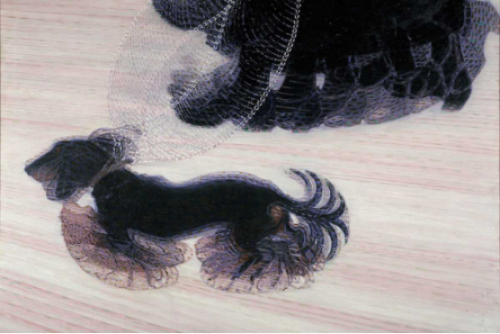
No comments:
Post a Comment